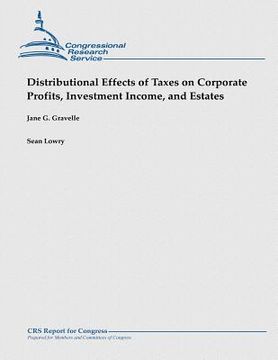Distributional Effects of Taxes on Corporate Profits, Investment Income, and Estates (in English)
Synopsis "Distributional Effects of Taxes on Corporate Profits, Investment Income, and Estates (in English)"
Tax reductions enacted in 2001-2004 reduce the effective tax rate on capital income in several different ways. Taxes on capital arise from individual taxes on dividends, interest, capital gains, and income from non-corporate businesses (proprietorships and partnerships). Reductions in marginal tax rates, as well as some tax benefits for business, reduce these taxes. Taxes on capital income also arise from corporate profits taxes, which are affected not only by rate reductions but also by changes to provisions affecting depreciation, interest deductions, other deductions and credits. Finally, taxes can be imposed on capital income through the estate and gift tax. Tax cuts on capital income through capital gains rate reductions, estate and gift tax reductions, and dividend relief are estimated to cost about $57 billion per year, with about half that amount attributable to the estate and gift tax. Lower ordinary tax rates also affect income from unincorporated businesses. These tax cuts are temporary and proposals to make some or all of them permanent are expected. Bonus depreciation appears less likely to be extended. While there are many factors used to evaluate the effects of these tax revisions, one of them is the distributional effect. This report addresses those distributional issues, in the context of behavioral responses. Data suggest that taxes on capital income tend to fall more heavily on high-income individuals. All types of capital income are concentrated in higher-income classes. For example, the top 2.8% of tax returns (with adjusted gross income over $200,000 in 2009) have 26% of income, 19% of wages, 39% of interest, 39% of dividends, and 57% of capital gains. Taking into account a very broad range of capital assets, a 2012 Treasury study found that the top 1% of the population has about 19% of total income and about 12% of labor income, but receives almost half of total capital income. Estate and gift taxes are especially concentrated in the higher incomes: prior to the tax cuts enacted in 2001-2004, only 2% of estates paid the estate tax at all. If there is a significant reduction in savings in response to capital income taxes, in the long run the tax could be shifted to labor and thus become a regressive tax. Some growth models are consistent with such a view, but generally theory suggests that increases in taxes on capital income could either decrease or increase savings, depending on a variety of model assumptions and particularly depending on the disposition of the revenues. There are also many reasons to be skeptical of these models, which presume a great deal of skill and sophistication on the part of individuals. New models of bounded rationality suggest that taxes on capital income are likely to have no effect or decrease saving, as individuals rely on common rules of thumb such as saving a fixed fraction of income and saving for a target. Empirical evidence in general does not suggest significant savings responses, as savings rates and pre-tax returns to capital have been relatively constant over long periods of time despite significant changes in tax rate. If capital income taxes do not reduce saving, these taxes fall on capital income and add to the progressivity of the income tax system.

